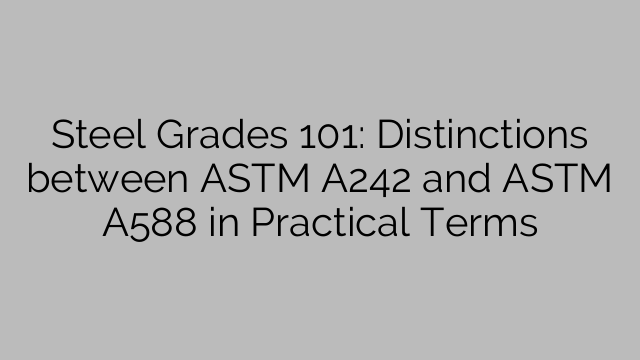Steel Grades 101: Distinctions between ASTM A242 and ASTM A588 in Practical Terms
Steel is an essential material in various industries, offering durability, strength, and versatility for countless applications. However, not all steels are created equal, and different grades can have significant distinctions in terms of performance and applications. In this article, we will focus on two popular high-strength, low-alloy (HSLA) steels, ASTM A242 and ASTM A588, and discuss their practical differences.
The American Society for Testing and Materials (ASTM) sets the standards for various steel grades, ensuring consistent quality and performance across the industry. ASTM A242 and ASTM A588 are both high-strength, low-alloy steels commonly used in structural applications, but they do have some key distinctions that make them suited for specific uses.
1. Corrosion Resistance:
One of the primary differences between ASTM A242 and ASTM A588 is their corrosion resistance properties. ASTM A242 is primarily used in atmospheric conditions and is known for its resistance to atmospheric corrosion due to the formation of a protective oxide layer on the steel surface. This layer acts as a barrier, preventing further corrosion and extending the lifespan of the steel.
On the other hand, ASTM A588 is specifically designed for applications requiring higher corrosion resistance, particularly in more aggressive environments. It contains alloying elements such as copper, nickel, and chromium, which enhance its corrosion resistance capabilities. ASTM A588 is often used in marine environments, bridges, and other structures exposed to harsh weather conditions.
2. Strength and Mechanical Properties:
Both ASTM A242 and ASTM A588 are high-strength steels, providing excellent mechanical properties that make them suitable for structural applications. However, they differ in terms of their yield and tensile strengths.
ASTM A242 has a minimum yield strength of 50,000 psi (345 MPa) and a minimum tensile strength of 70,000 psi (483 MPa). It offers excellent weldability, formability, and machinability, making it a versatile choice for various structural projects.
In contrast, ASTM A588 has a minimum yield strength of 50,000 psi (345 MPa) and a minimum tensile strength of 70,000 psi (483 MPa) as well. However, ASTM A588 is known for its higher strength-to-weight ratio, allowing for lighter structures without compromising structural integrity.
3. Applications:
The distinct properties of ASTM A242 and ASTM A588 make them suitable for different applications. ASTM A242 is commonly used in outdoor structures such as bridges, buildings, and architectural elements where its atmospheric corrosion resistance offers a significant advantage.
On the other hand, ASTM A588 is often selected for more demanding applications, including marine environments, structural components in bridges, and even in unpainted applications such as sculptures or artistic structures. Its higher corrosion resistance and strength make it a preferred choice in areas prone to aggressive weather conditions.
When it comes to choosing between ASTM A242 and ASTM A588, it is important to consider the specific requirements of the project. Factors such as environmental conditions, structural design, and the desired lifespan of the structure should be carefully evaluated to make an informed decision.
In conclusion, the distinctions between ASTM A242 and ASTM A588 lie in their corrosion resistance, strength, and practical applications. While ASTM A242 offers excellent atmospheric corrosion resistance and versatility, ASTM A588 provides higher corrosion resistance and strength for more demanding environments. By understanding these differences, engineers and designers can select the most appropriate steel grade for their specific structural needs, resulting in durable and reliable structures.

